For aficionados of historical television, particularly those with a penchant for Edwardian era narratives, ‘The Duchess Of Duke Street’ (1976-1977) emerges as a captivating series currently available for streaming on Amazon Prime Video. Initially, Edwardian costumes might not strike everyone as immediately appealing, yet this BBC production, created by the same team behind ‘Upstairs, Downstairs’, offers much more than just period aesthetics. The series, anchored by Gemma Jones’ compelling portrayal of the eponymous “duchess,” transcends costume drama to deliver a rich story of social mobility, culinary ambition, and compelling character development.
Louisa Trotter, the central figure of ‘The Duchess of Duke Street’, is loosely inspired by the real-life Rosa Lewis, a remarkable woman who reputedly began her ascent into gastronomic fame through connections to Edward VII. Similar to ‘Upstairs, Downstairs’, the series adeptly navigates social strata, portraying Louisa’s journey as she seamlessly moves between different societal echelons, albeit not without facing her share of challenges. For viewers with an interest in culinary history, the show provides a delightful glimpse into early 20th-century cuisine, moving beyond simplistic notions of the era’s palate.
The costume design, helmed by Betty Aldiss, adheres to the meticulous period detail characteristic of 1970s BBC productions. As Louisa’s role evolves from kitchen assistant to a prominent figure in high society, the costumes become increasingly elaborate and visually engaging. This transformation mirrors Louisa’s own ascent, offering viewers a fascinating study in Edwardian fashion as it transitions from the late Victorian era into the early 20th century. The series timeline spans from the final year of Queen Victoria’s reign well into the 1920s, providing a comprehensive visual and narrative arc of this transformative period.
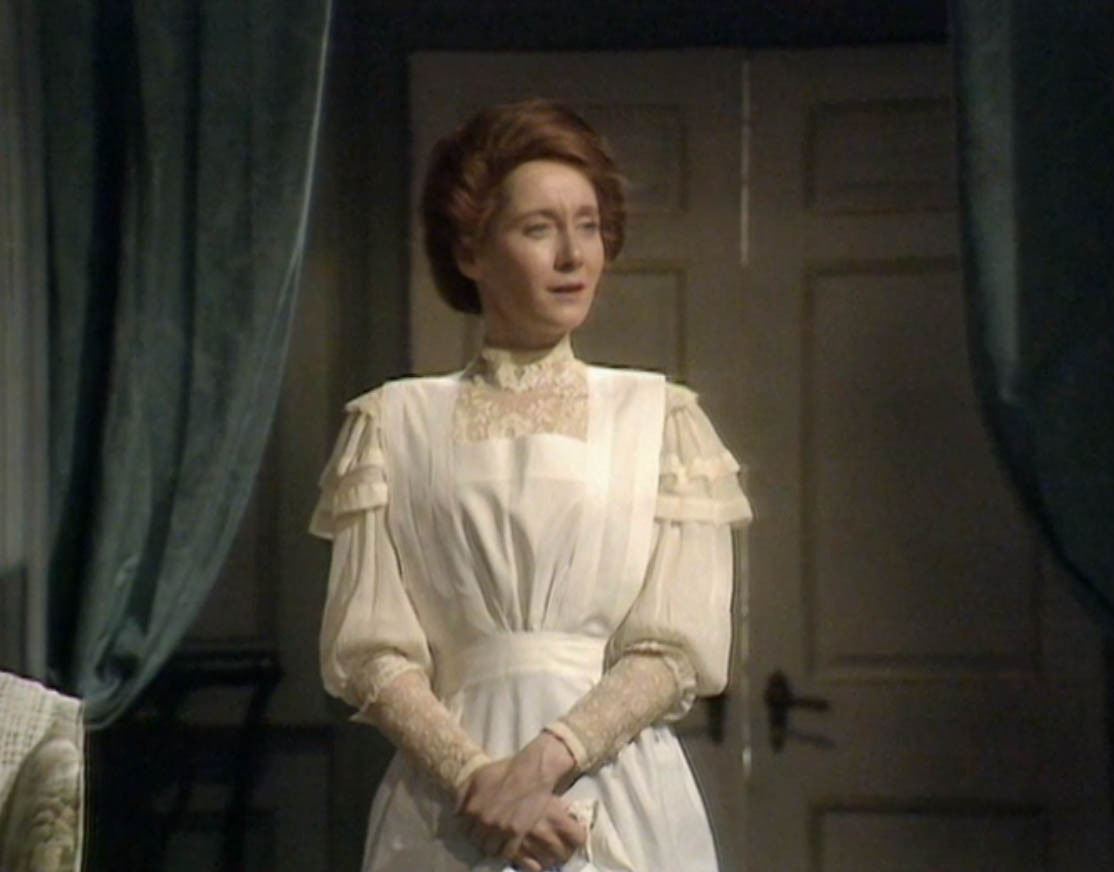 Louisa Trotter in her working attire, showcasing a practical yet subtly stylish apron, hinting at her dynamic personality.
Louisa Trotter in her working attire, showcasing a practical yet subtly stylish apron, hinting at her dynamic personality.
Early in the series, even in her more functional kitchen attire, Louisa’s burgeoning personality shines through. Her working wear, while practical, doesn’t diminish her spirited nature. This contrast between practicality and underlying dynamism is a recurring theme in her character and costume choices throughout ‘The Duchess of Duke Street’.
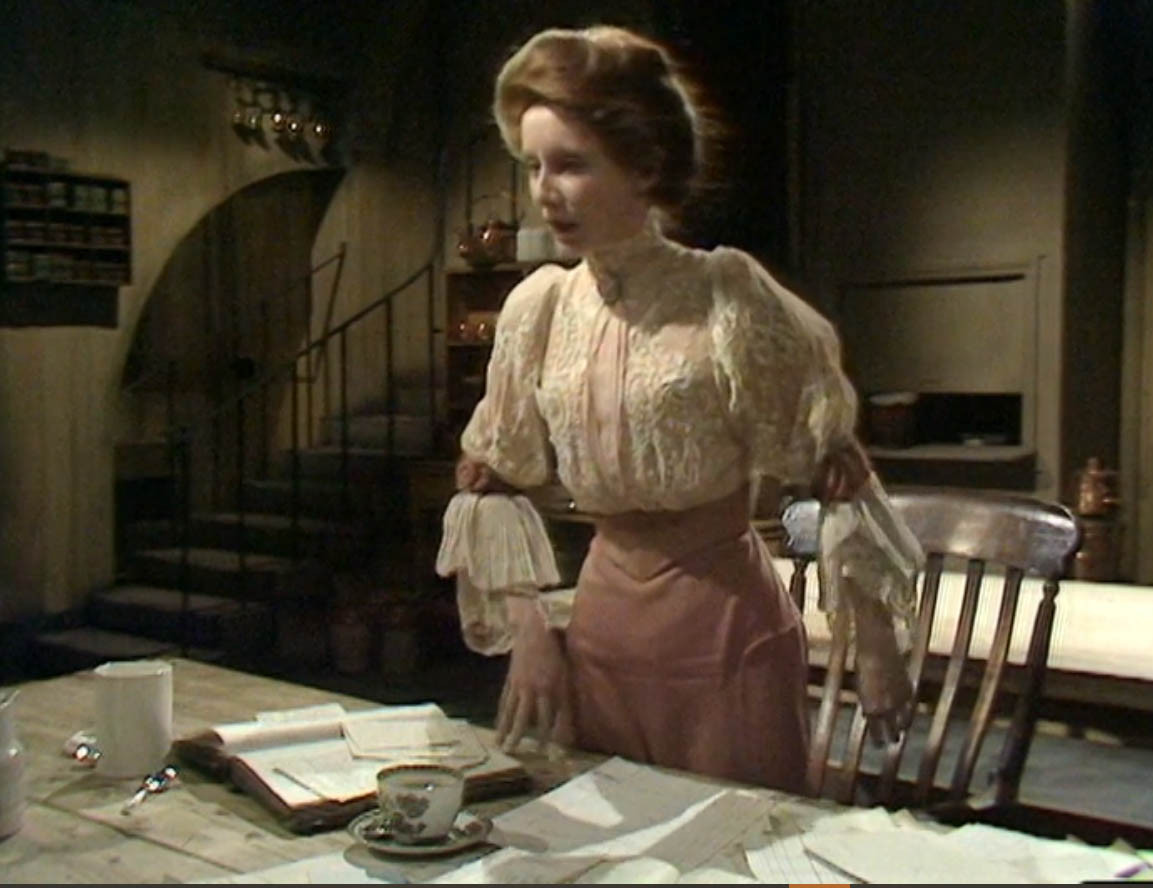 Louisa Trotter in a lacy blouse and skirt, emphasizing the feminine yet determined aspects of her character.
Louisa Trotter in a lacy blouse and skirt, emphasizing the feminine yet determined aspects of her character.
As Louisa begins to navigate higher social circles, her wardrobe evolves to reflect her changing status, yet it always retains elements of her strong personality. Feminine blouses and skirts are featured, but they do little to conceal Louisa’s inherent determination and fiery spirit, traits that propel her success in the demanding world she inhabits.
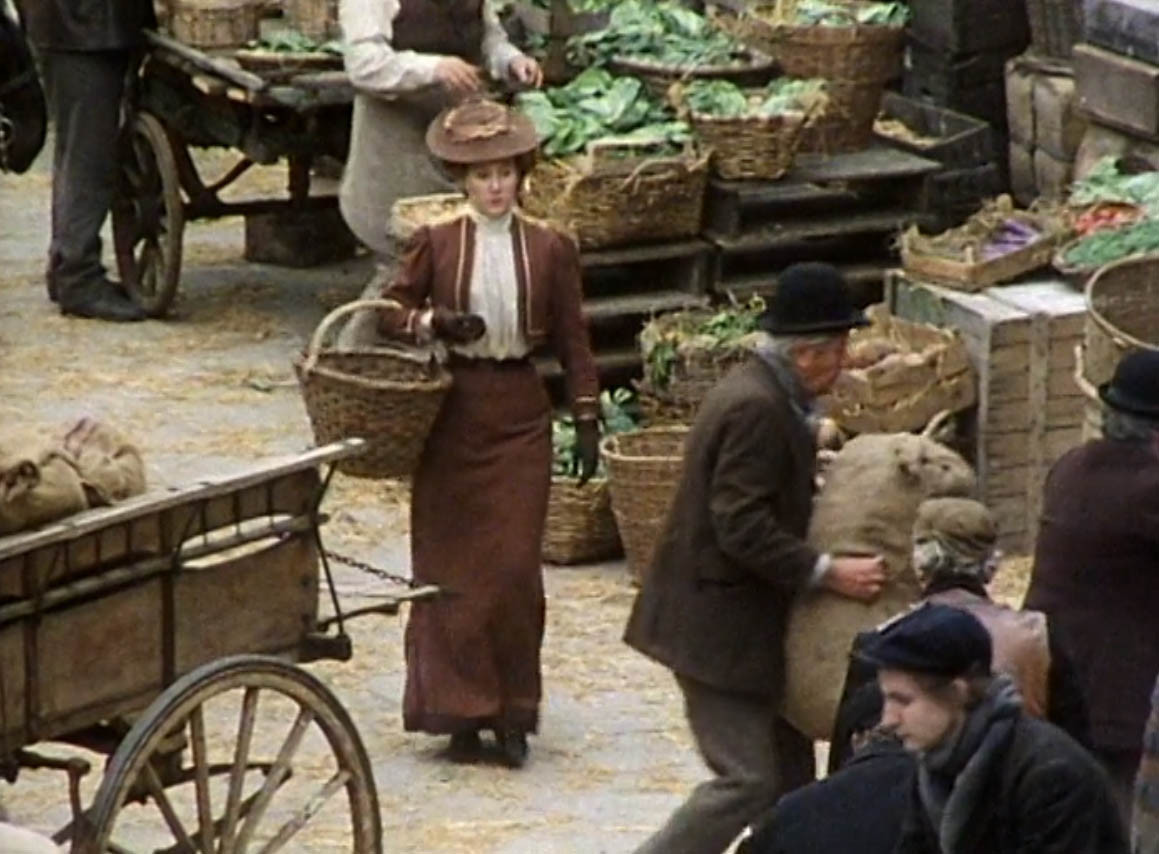 Louisa Trotter's smart morning market outfit, featuring a subdued brown wool jacket and skirt paired with a crisp white shirtwaist and hat, reflecting early 20th-century daywear elegance.
Louisa Trotter's smart morning market outfit, featuring a subdued brown wool jacket and skirt paired with a crisp white shirtwaist and hat, reflecting early 20th-century daywear elegance.
Louisa’s market outfit exemplifies the smart and understated elegance of early 20th-century daywear. The brown wool jacket and skirt, combined with a crisp white shirtwaist and stylish hat, showcase the practical yet refined fashion sensibilities of the era for a woman of her position. This attention to detail in everyday wear is a hallmark of the series’ costume design.
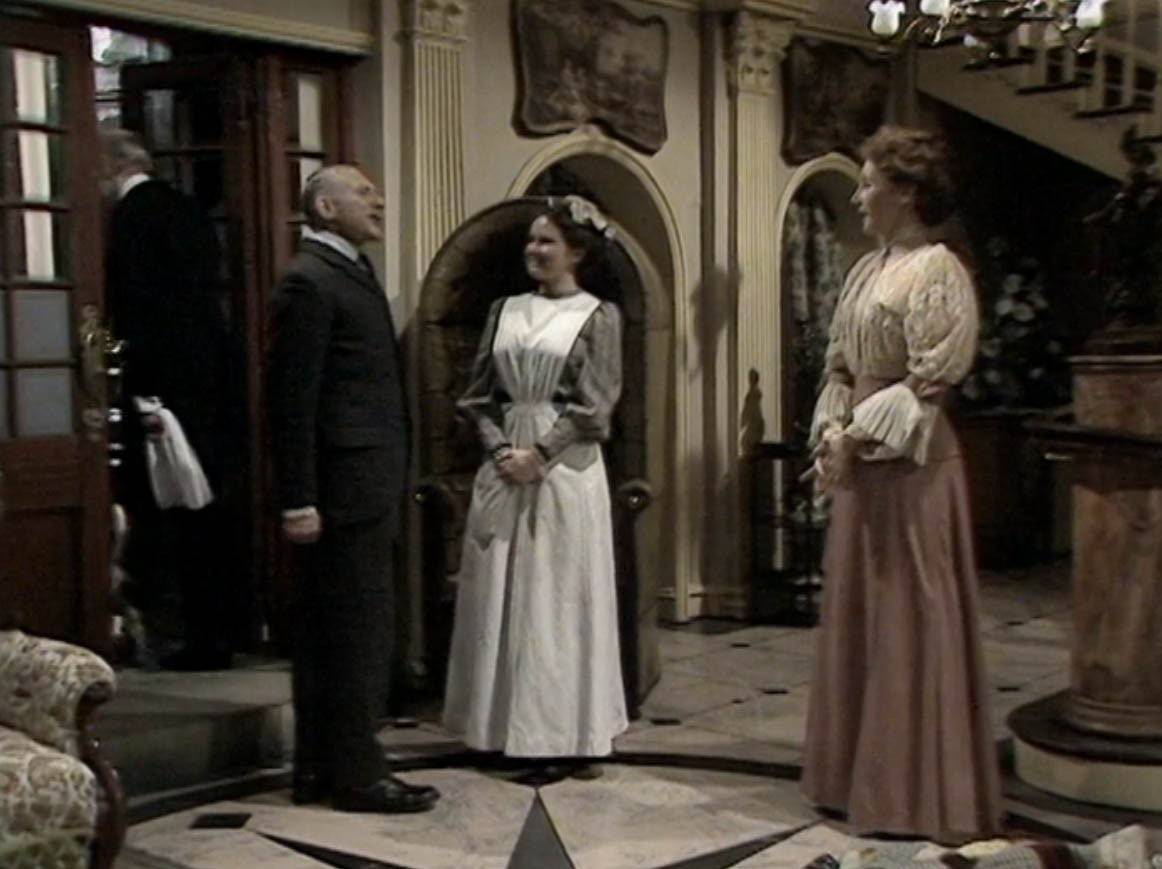 Mary and Starr, Louisa's key staff members, portrayed with nuanced costumes that hint at their developing roles and backstories within the series.
Mary and Starr, Louisa's key staff members, portrayed with nuanced costumes that hint at their developing roles and backstories within the series.
‘The Duchess of Duke Street’ extends its costume narrative beyond its lead. Louisa’s key staff, like her right-hand woman Mary and the doorman Starr, are also given depth through costume. Their evolving wardrobes hint at their own side plots and backstories, enriching the tapestry of the series and demonstrating that costume significance extends to the supporting cast.
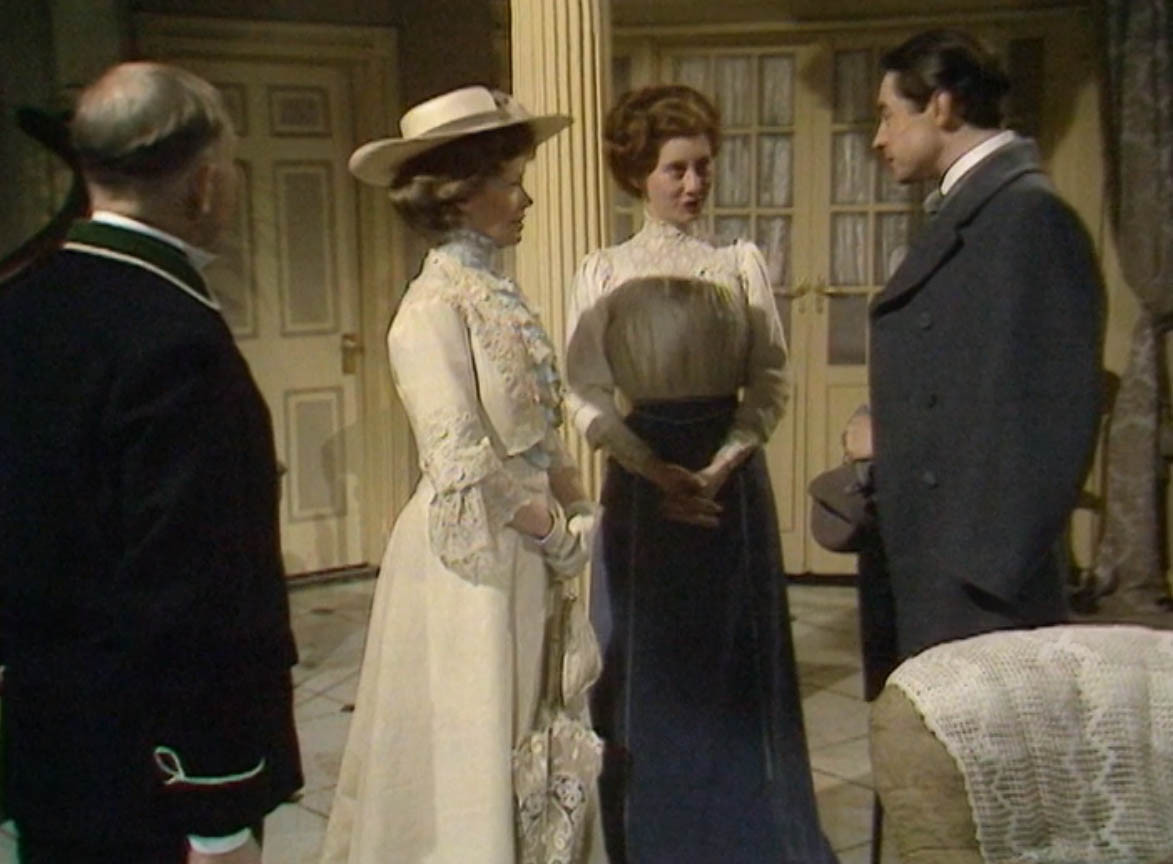 A tableau of Edwardian fashion, highlighting the visual appeal of women's attire in 'The Duchess of Duke Street'.
A tableau of Edwardian fashion, highlighting the visual appeal of women's attire in 'The Duchess of Duke Street'.
For those captivated by Edwardian women’s fashion, ‘The Duchess of Duke Street’ is visually rich. The series is replete with examples of the era’s stylistic nuances, offering ample “eye candy” for viewers who appreciate the elegance and detail of early 20th-century clothing.
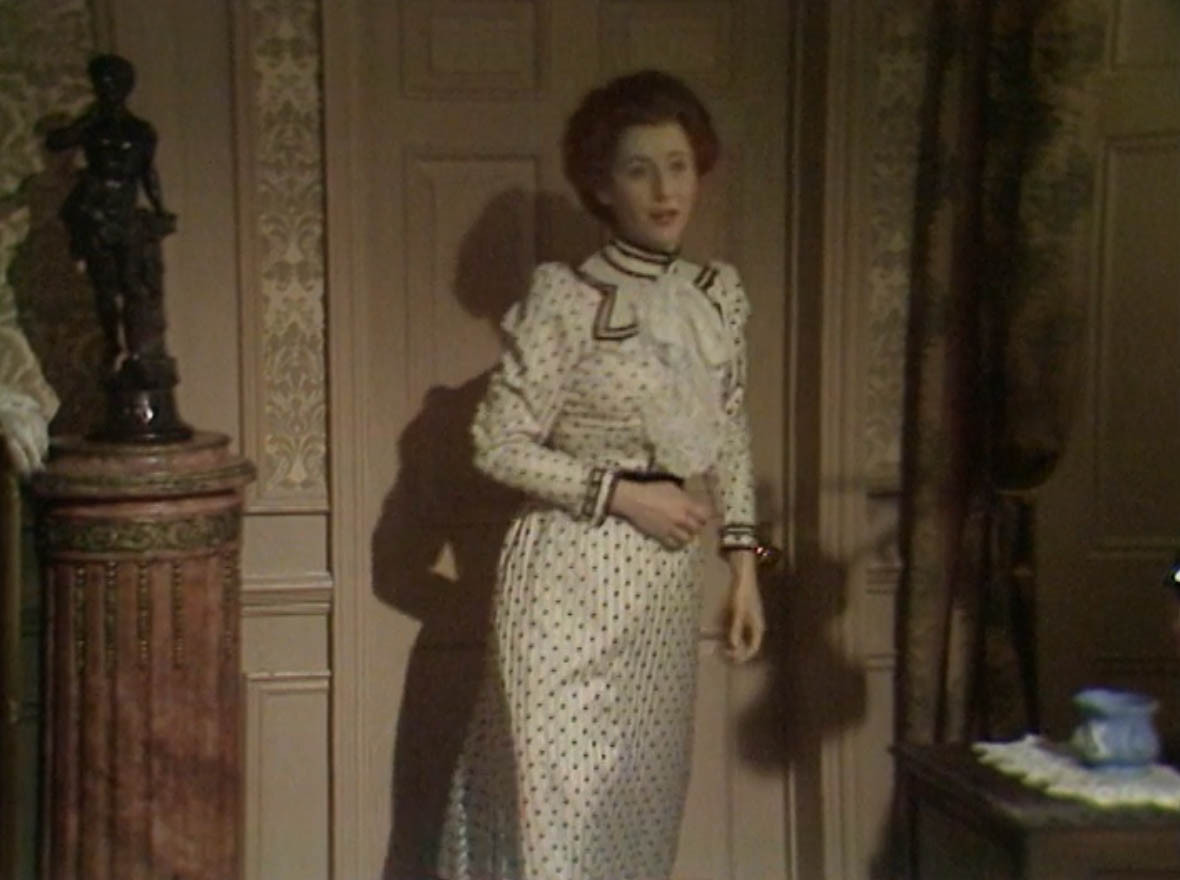 Louisa in her favorite white silk dress with black accents, a sophisticated design that embodies early 20th-century fashion.
Louisa in her favorite white silk dress with black accents, a sophisticated design that embodies early 20th-century fashion.
One standout costume for Louisa is a white silk dress adorned with black dots and edging. This particular garment exemplifies the sophisticated detailing prevalent in early 20th-century fashion, showcasing the elegance and subtle ornamentation of the period’s designs.
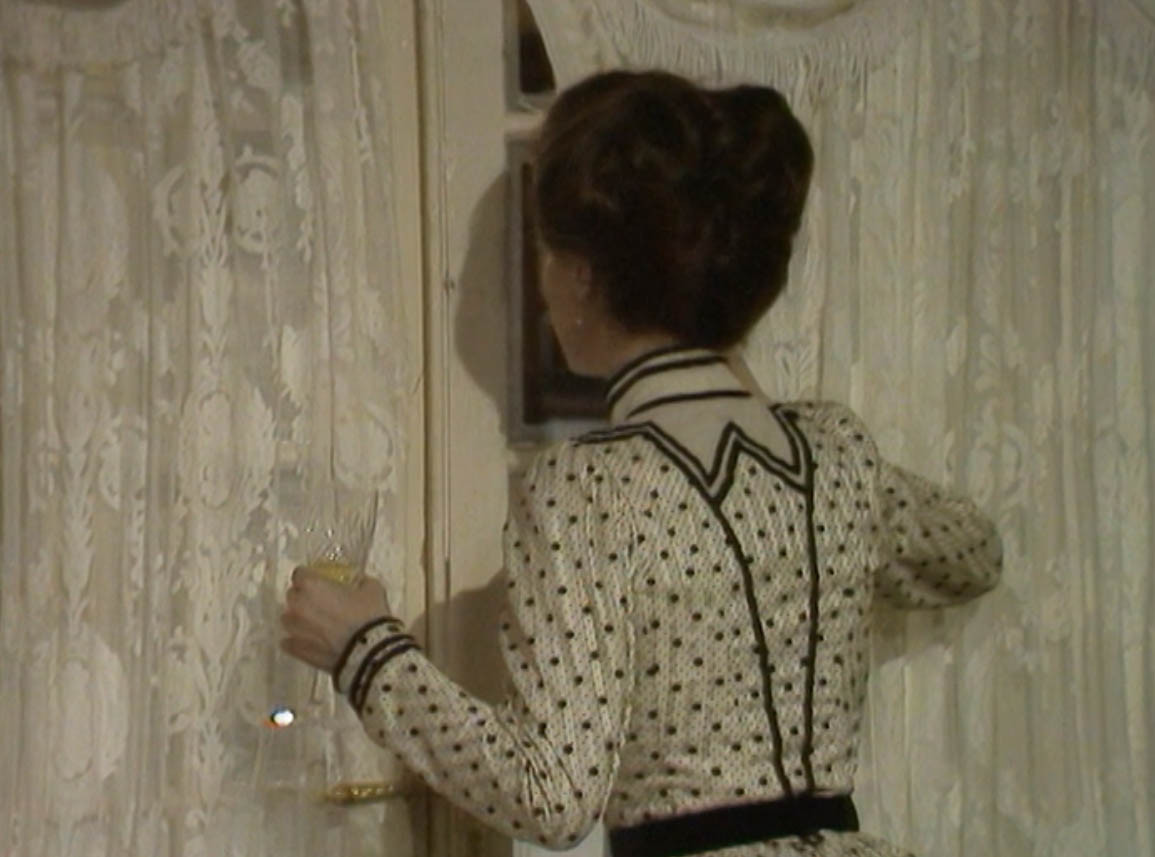 The detailed back view of Louisa's white silk dress, revealing the cream fabric with self-stripe and woven black dots, emphasizing the high-quality and intricate design.
The detailed back view of Louisa's white silk dress, revealing the cream fabric with self-stripe and woven black dots, emphasizing the high-quality and intricate design.
A closer look at the white dress reveals its refined fabric and construction. The cream fabric with a self-stripe, overlaid with woven black dots, highlights the high quality of BBC costuming even in older productions. The detailing around the yoke further emphasizes the classiness and attention to period-accurate details.
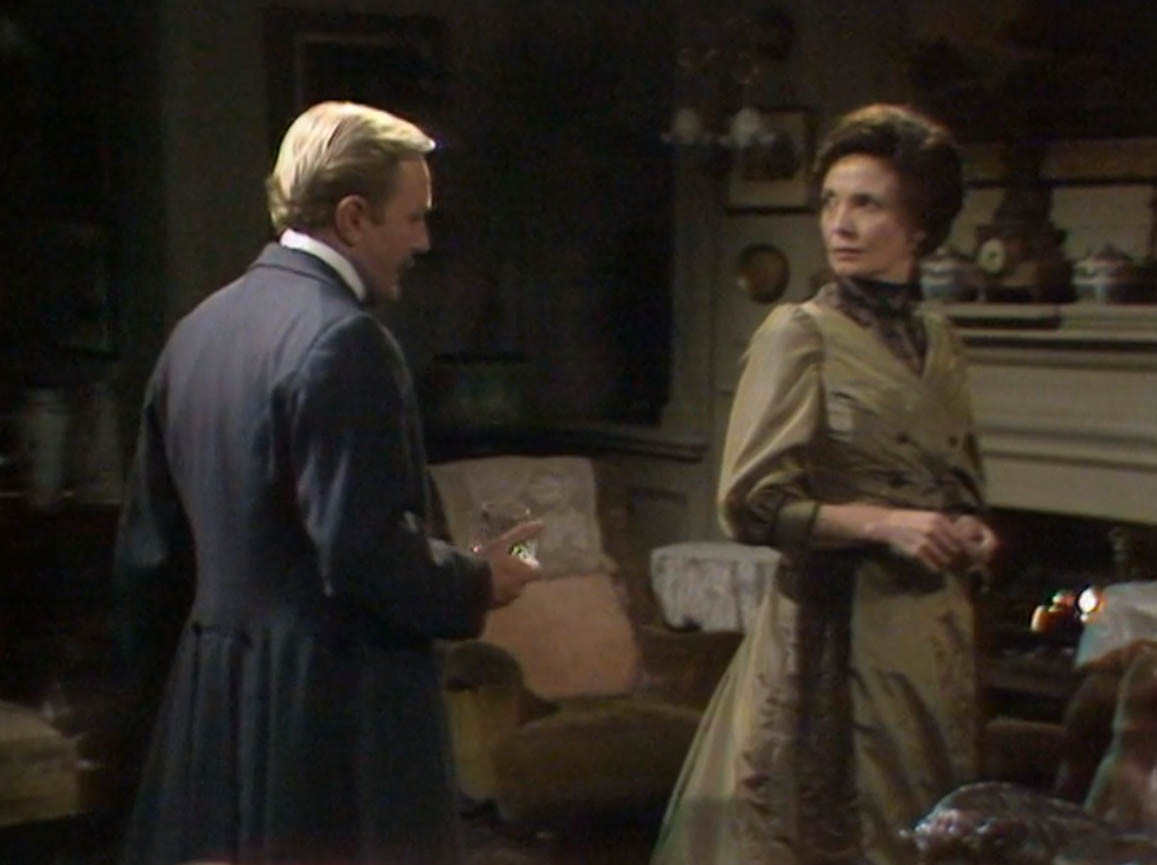 Guests at the Bentinck Hotel showcasing fabulous and posh wardrobes, illustrating the societal context of 'The Duchess of Duke Street'.
Guests at the Bentinck Hotel showcasing fabulous and posh wardrobes, illustrating the societal context of 'The Duchess of Duke Street'.
The sartorial richness of ‘The Duchess of Duke Street’ isn’t limited to Louisa. Guests at the Bentinck Hotel also boast impressive wardrobes, reflecting their affluent social standing and adding layers to the series’ portrayal of Edwardian society. These costumes serve to illustrate the stratified world Louisa navigates.
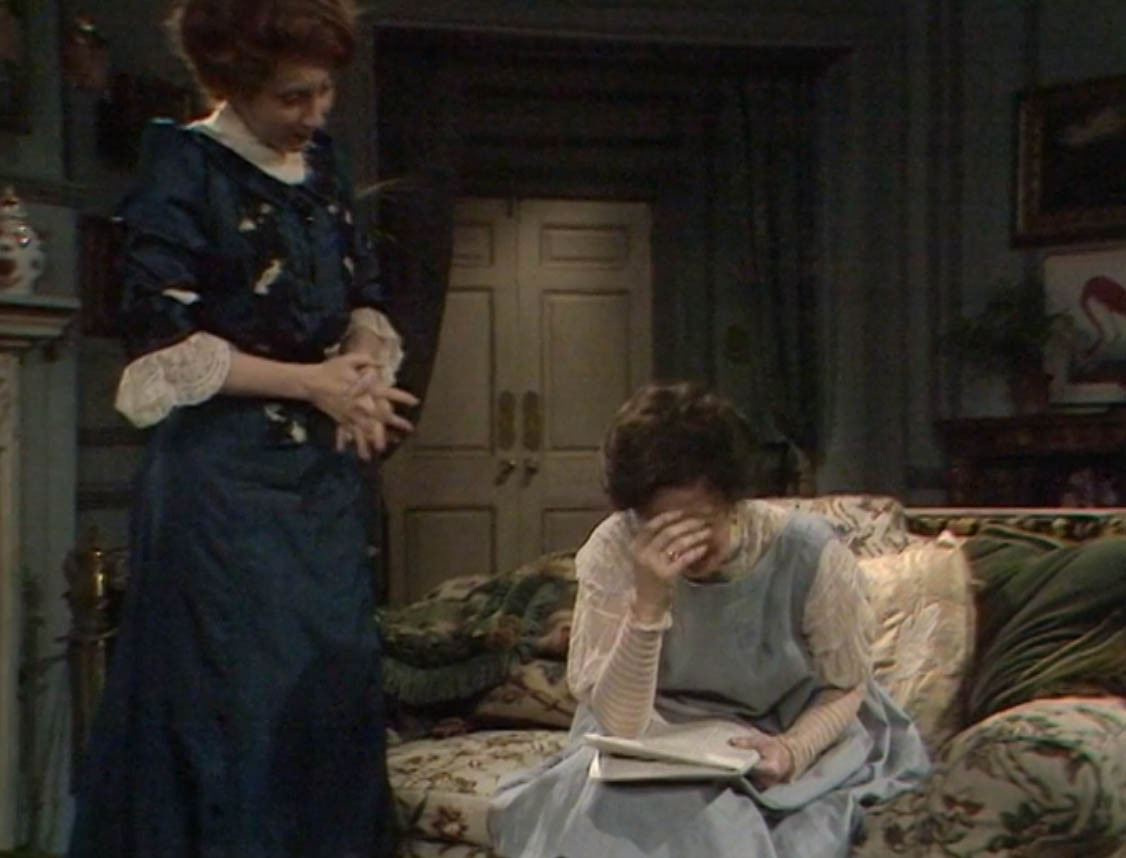 Louisa in a dark blue silk gown with black lace, a testament to the opulent evening wear featured in the series, despite the limitations of older film quality.
Louisa in a dark blue silk gown with black lace, a testament to the opulent evening wear featured in the series, despite the limitations of older film quality.
Louisa’s dark blue silk gown with black lace inserts exemplifies the opulent evening wear featured in ‘The Duchess of Duke Street’. Despite the limitations of older film quality inherent in vintage BBC productions, the costume details remain discernible, showcasing the commitment to period accuracy even within technical constraints. The series prioritizes costume and set authenticity, sometimes at the expense of pristine visual fidelity.
 Louisa in her creamy white satin evening gown, worn in pivotal scenes with Prince Edward and later with another suitor, highlighting the gown's significance across different storylines.
Louisa in her creamy white satin evening gown, worn in pivotal scenes with Prince Edward and later with another suitor, highlighting the gown's significance across different storylines.
A creamy white satin evening gown appears in multiple significant episodes, first during Louisa’s initial encounter with Prince Edward and later in a rendezvous with another suitor. This repeated use of a key costume underscores its importance and subtly highlights Louisa’s evolving relationships and social maneuvering within the narrative.
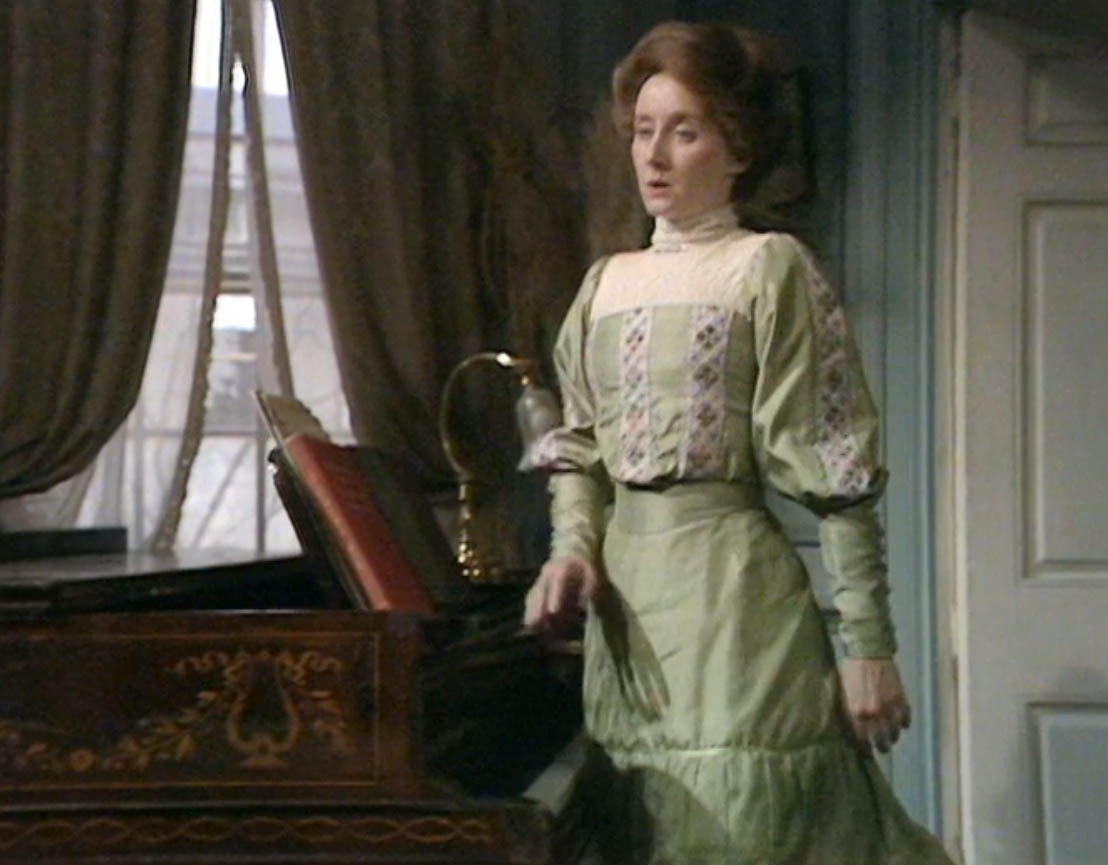 Another daywear ensemble of Louisa, illustrating the pigeon breast bodice and fuller sleeves typical of early 20th-century fashion trends.
Another daywear ensemble of Louisa, illustrating the pigeon breast bodice and fuller sleeves typical of early 20th-century fashion trends.
Another of Louisa’s daywear looks accurately captures early 20th-century silhouettes. The slight pigeon breast at the front of the bodice and the fuller sleeves are characteristic of the period’s fashion trends, further demonstrating the costume department’s dedication to historical accuracy.
 Louisa in her morning gown, showcasing the variety of styles an upper-class woman would wear throughout the day in the Edwardian era.
Louisa in her morning gown, showcasing the variety of styles an upper-class woman would wear throughout the day in the Edwardian era.
‘The Duchess of Duke Street’ meticulously showcases the diverse wardrobe of an upper-class Edwardian woman. Louisa is consistently dressed in appropriate attire for various times of day and social situations, from morning gowns to evening wear, providing a comprehensive view of the era’s fashion landscape.
‘The Duchess of Duke Street’ is more than just a visually appealing period drama; it’s a compelling character study set against the backdrop of early 20th-century Britain. Gemma Jones’ performance, combined with the rich costume design and engaging storylines, makes it a worthwhile watch for anyone interested in historical television. Have you explored the world of ‘The Duchess of Duke Street’? Share your thoughts in the comments below!
